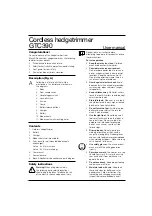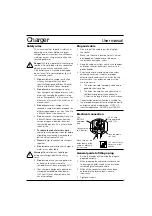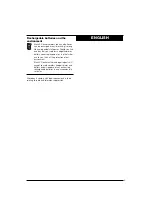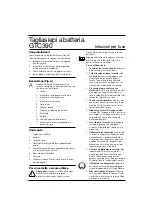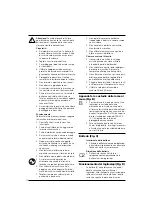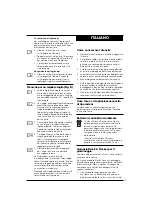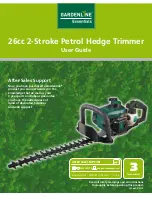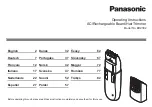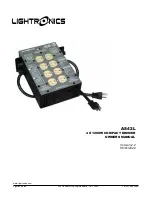
5
Switching your hedgetrimmer on
For your safety, your hedgetrimmer is fitted
with the handle trigger switch (3) which has a
lock-off switch (4) to prevent inadvertent
switching on.
D1
•
Squeeze the front handle switch (2).
•
Push the lock-off switch (4) forward with
your thumb and squeeze the trigger
switch (3) to start your hedgetrimmer.
•
The lock-off switch can then be released
once the trigger switch (3) has been
squeezed.
Switching your hedgetrimmer off
D2
•
By releasing the front handle switch (2) or
the handle trigger switch (3) your
hedgetrimmer will stop immediately.
Cutting techniques for better results
(Fig. E)
E1
•
The blades will cut most effectively when
they are not exactly parallel with the line
of cut, but have the tips of the blades
pointing slightly towards the hedge. This
lateral tilt should not exceed 15˚ to the
line of cut.
E2
•
Most users trim the top of the hedge
first. Hold your hedgetrimmer at the
desired angle and move it steadily along
the line of cut. The double edged blade
enables you to cut in either direction or
with a side to side movement.
E3
•
For a very level finish a piece of string
can be stretched along the length of the
hedge at the required height to serve as
a guide line. The hedge may then be cut
just above the string.
E4
•
To keep the sides of the hedge flat, it is
better to cut upwards with the growth.
Younger stems move outwards when the
blade cuts downwards and can cause
shallow patches in the hedge.
E5
•
Take care to avoid hard objects such as
wire which could cause damage to the
cutting blades.
If your hedgetrimmer stalls, release the
trigger immediately. Stalling will reduce
cutting time and should be avoided. Before
removing obstructions from the blades
always remove the energy pack to prevent
inadvertent operation.
Remember that your hedgetrimmer is also
suitable for trimming most shrubs, brambles
or any neglected areas within your garden.
ENGLISH
Care and maintenance
•
Remove the battery before cleaning or adjusting
your hedgetrimmer.
•
For best performance, keep the blades and air
slots in the motor housing clean. Use a cloth or
brush to remove cutting, sap or other debris.
•
Prevent the blades from rusting by applying a film
of light machine oil after cleaning.
•
Plastic parts may be cleaned by using a non
abrasive cleaner and a cloth dampened with
warm water.
•
Do not immerse any part of your hedgetrimmer
in water.
•
Avoid all other types of detergents, cleaners or
solvents, These may contain chemicals that
could seriously damage the plastic. Do not spray
your hedgetrimmer with water, and do not allow
water to enter your hedgetrimmer.
•
Self lubricating bearings are used in the tool and
lubrication is not required.
What to do if your hedgetrimmer
needs repair
Information on how and where to send your
hedgetrimmer for repair or service is given on the
reverse of the parts diagram. We recommend you
keep this in a safe place.
Rechargeable batteries and the
environment
Cd
Black & Decker cordless tools and batteries
can be recharged many times and give long
life and repeatedly full power. Should you find
one day that your cordless hedgetrimmer or
battery needs replacement, or is of no further
use to you, think of the protection of our
environment.
Black & Decker authorised repair agents will
accept your old cordless hedgetrimmer and
battery and will dispose of any exhausted
rechargeable batteries in an environmentally
safe way.
Black & Decker lawn and garden
guarantee
This guarantee provides: 36 months parts cover and
12 months labour (UK), 24 months parts cover and
labour (Australia) and 12 months replacement
product cover (New Zealand).




